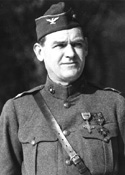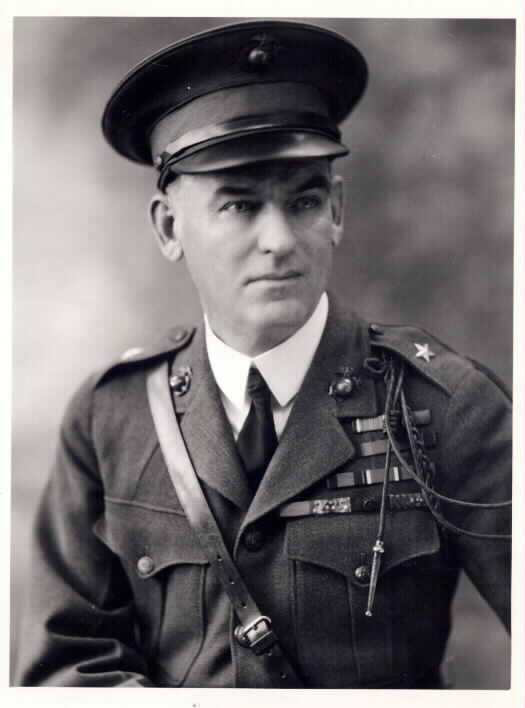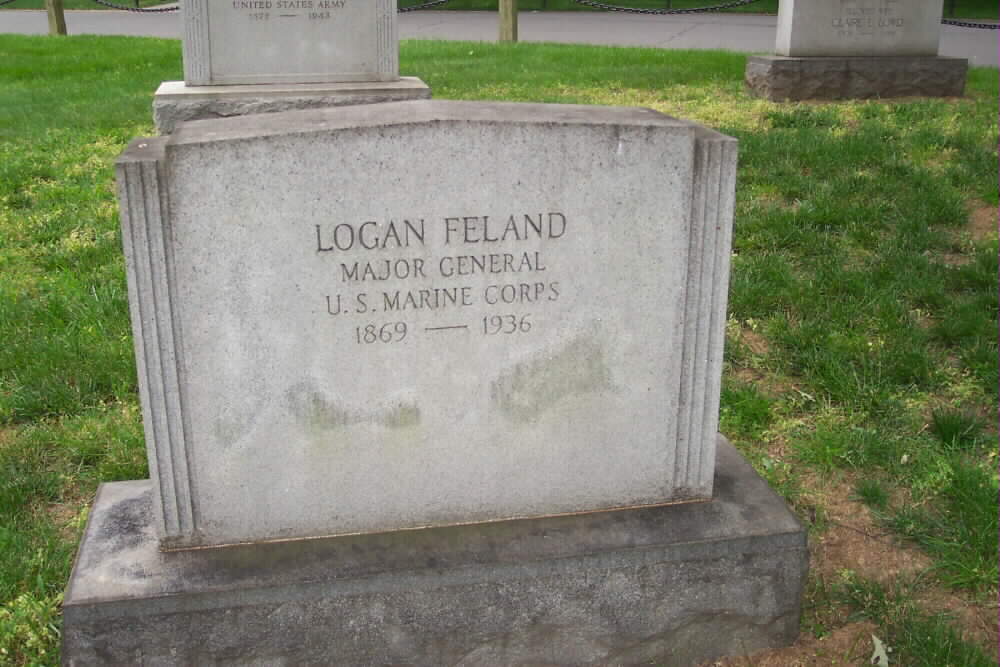
He was appointed First Lieutenant, United States Marine Corps, July 1, 1899; Captain, March 3, 1903; Major, August 20, 1916; Lieutenant Colonel, March 26, 1917; Colonel (temporary), July 1, 1918; Brigadier General (temporary), March 9, 1919; appointment as Brigadier General was made permanent on July 1, 1920; appointed Major General, November 12, 1919.
Served in Cuba, the Philippines, Panama, Santo Domingo and various stations at sea. He arrived in France for World War I duty on June 13, 1917. He was awarded the Distinguished Service Cross for “energy, courage and disregard of personal safety” in leading troops into actionl; the Distinguished Service Medal for “exceptionally meritorious and distinguished service during the World War.” He also received SIX awards of the Croix de Guerre, one with a bronze star for “generously contributing” to the success of the French 116th Infantry, one with palm for “remarkable ardor and tenacity in driving the enemy back for a distance of 11 kilometers.” Another Croix de Guerre with palm for “coolness and skill in command of troops in the Bois de Belleau.” Another Croix de Guerre with palm for “glorious part taken by his regiment in the attack t Champagne, ebetween Blanc Mont nd Medeah Fram.” He was made an Officer of the Legion of Honor and awarded a Croix de Guerre with a gold star for “services in an attack south of Soissons,” July 18, 1918. He received the US Navy Distinguished Service Medal for “distinguished and gallant services.” He was cited six times in divisional orders for gallantry.
He was commander, 5th US Marine Regiment, July 17-November 11, 1918. Commander, 2nd Brigade of Marines at Santo Domingo, December 4, 1919-October 24, 1920. Commander of U.S. Forces on shore in Nicaragua. 1927-29. He retired as a Major General, September 1, 1933, and returned to his home in Columbus, Ohio.
He died on July 17, 1936 and was buried in Section 7 of Arlington National Cemetery.
Courtesy of the United States Marine Corps:
Major General Logan Feland was born in Hopkinsville, Kentucky, on August 11, 1869. During the War with Spain he was Captain of Company F, 3d Kentucky Infantry. By virtue of his previous military experience he was appointed directly to the rank of first lieutenant in the Marine Corps on July 1, 1899. He was promoted to captain, March 3, 1903; to major, August 29, 1916; to lieutenant colonel, March 26, 1917; to colonel July 1, 1918; to brigadier general, March 9, 1919; and to major general, October 1, 1931.
In the grades of lieutenant and captain he served with Marine detachments on USS Oregon, Massachusetts, Indiana, Minnesota, and Montana. Prior to World War I he had more than eight years of foreign duty including service in Panama in 1904 and in 1911; expeditions to Guantanamo Bay in 1904, 1911, 1912, and 1913; San Juan, Puerto Rico, in 1904; service with the Army of Cuban Pacification in 1906; service in Santo Domingan waters in 1912; Culebra in 1914; and the occupation of Vera Cruz, Mexico, in 1914. His home service was equally varied and included duty at Marine Barracks, Washington, D.C., League Island (Philadelphia), Narragansett Bay, Rhode Island, Norfolk, and New York; instruction in submarine mining at the Torpedo Station, Narragansett Bay; teaching in the School of Application, Annapolis, and the Advanced Base School, New London, Connecticut; observation of Army artillery practice at Fortress Monroe, Virginia; the supervising of construction of new barracks at Annapolis; and recruiting in New York.
Feland was attached to the 5th Regiment for service in France in World War I and was among the first contingent of American forces which went overseas with General Pershing in May 1917. On his arrival in France, Feland was made executive officer of the 5th Regiment. When the unit, as part of the 4th Marine Brigade, was thrown into the breach to stem the German advance at Chateau Thierry in May 1918, Feland was ever in the thick of the fighting. At Belleau Woods in June 1918 when the halt in the German advance was turned into a retreat, Feland was given command of all troops in the Wood. His conspicuous valor on this occasion won him the Distinguished Service Cross. After his promotion to colonel, Feland became commanding officer of the 5th Regiment and as such led it in the Battles of Soissons, Blanc Mont Ridge and in the Argonne. For his outstanding exploits in the War, Feland was awarded, in addition to the Distinguished Service Cross mentioned above, the Distinguished Service Medals of both the Army and the Navy, Officer’s rank in the Legion of Honor, the Croix de Guerre with bronze star, gold star, and four palms, and was cited in dispatches six times.
Upon his return to the United States in May 1919, Feland was stationed at Headquarters Marine Corps until December when he was detached to command the 2d Brigade in Santo Domingo. Returning to the United States the following fall, he again joined Headquarters in the capacity of Director of the Division of Operations and Training. He held that post for two years after which he was Assistant to the Major General Commandant for another two years. From November 1926 to February 1927 he was called from his command of the Marine Expeditionary Force at Quantico to head the Eastern Section of the U.S. Mail Guard.
In April 1927, Feland took command of the 2d Brigade in Nicaragua. After four months in Nicaragua he was transferred to the command of Marine Barracks, Parris Island, South Carolina, which post he held from September 1927 to January 1928. He then returned to Nicaragua and assumed command of the Brigade for a second time, serving there until March 1929. For this second tour in Nicaragua, Feland was awarded another Distinguished Service Medal.
Following a short period at Headquarters after his return from Nicaragua, Feland was assigned as Commanding General, Department of the Pacific in July 1929. He was serving in that position when he was detached on February 25, 1933. He retired on September 1, 1933 and died at Columbus, Ohio, on July 17, 1936. He was buried in Arlington National Cemetery.
Colonel Logan Feland, USMC
Citation:
The Distinguished Service Cross is presented to Colonel Logan Feland, U.S. Marine Corps, for extraordinary heroism in action during the operations at Bois de Belleau, June 6 – 14, 1918. Colonel Feland distinguished himself by his energy, courage, and disregard for personal safety in voluntarily leading troops into action through heavy artillery and machine-gun fire. His efforts contributed largely to our successes at this point.
FELAND, KATHERINE A WIDOW OF LOGAN
- DATE OF DEATH: 02/08/1946
- DATE OF INTERMENT: 02/12/1946
- BURIED AT: SECTION 7 SITE 10062-A
- ARLINGTON NATIONAL CEMETERY
- WIFE OF LOGAN FELAND – MAJ GEN USMC RET
FELAND, LOGAN
- MAJ GEN USMC
- VETERAN SERVICE DATES: Unknown
- DATE OF DEATH: 07/17/1936
- DATE OF INTERMENT: 07/22/1936
- BURIED AT: SECTION 7 SITE 10082-A
- ARLINGTON NATIONAL CEMETERY

Michael Robert Patterson was born in Arlington and is the son of a former officer of the US Army. So it was no wonder that sooner or later his interests drew him to American history and especially to American military history. Many of his articles can be found on renowned portals like the New York Times, Washingtonpost or Wikipedia.
Reviewed by: Michael Howard

